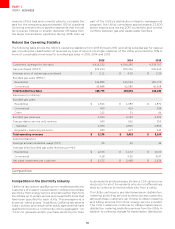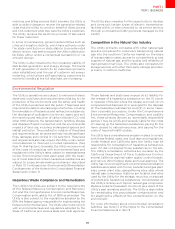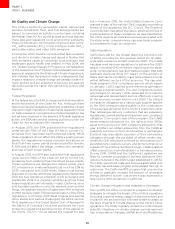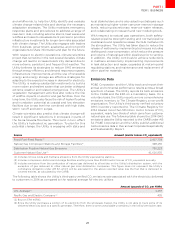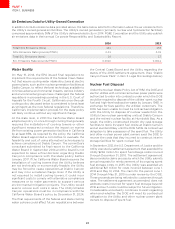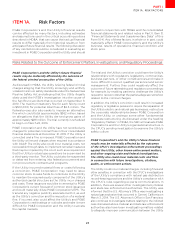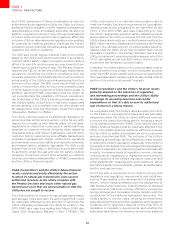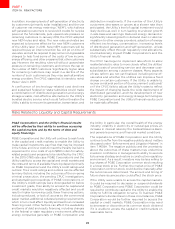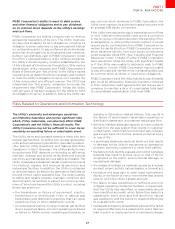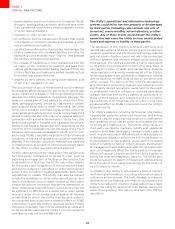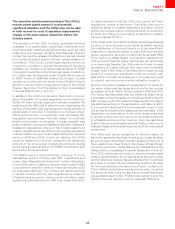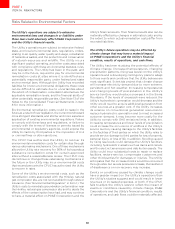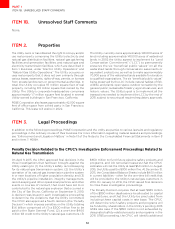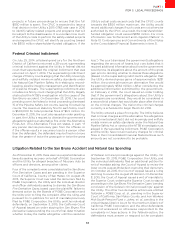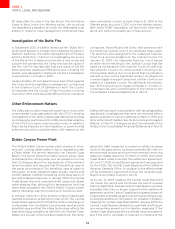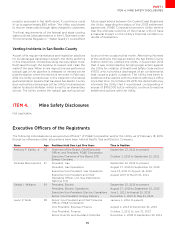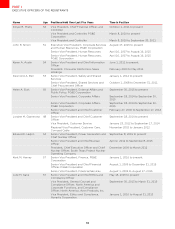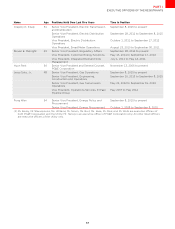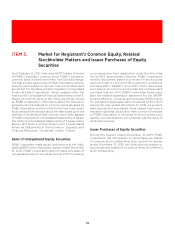PG&E 2015 Annual Report Download - page 36
Download and view the complete annual report
Please find page 36 of the 2015 PG&E annual report below. You can navigate through the pages in the report by either clicking on the pages listed below, or by using the keyword search tool below to find specific information within the annual report.
28
PART I
ITEM 1A.RISK FACTORS
đ
severe weather events such as storms, tornadoes, floods,
drought, earthquakes, tsunamis, wild land and other
fires, pandemics, solar events, electromagnetic events,
or other natural disasters;
đ operator or other human error;
đ
an ineective records management program that results
in the failure to construct, operate and maintain a utility
system safely and prudently;
đ
construction performed by third parties that damage the
Utility’s underground or overhead facilities, including, for
example, ground excavations or “dig-ins” that damage
the Utility’s underground pipelines;
đ
the release of hazardous or toxic substances into the
air, water, or soil, including, for example, gas leaks from
natural gas storage facilities; flaking lead paint from the
Utility’s facilities, and leaking or spilled insulating fluid
from electrical equipment;and
đ
attacks by third parties, including cyber-attacks, acts
of terrorism, vandalism, or war.
The occurrence of any of these events could interrupt
fuel supplies; aect demand for electricity or natural gas;
cause unplanned outages or reduce generating output;
damage the Utility’s assets or operations; damage the
assets or operations of third parties on which the Utility
relies; damage property owned by customers or others;
and cause personal injury or death. As a result, the Utility
could incur costs to purchase replacement power, to
repair assets and restore service, and to compensate third
parties. In particular, the Utility may incur material liability in
connection with a wildfire (known as the “Butte fire”) that
ignited and spread in Amador and Calaveras counties in
Northern California in September 2015 depending on the
outcome of the investigations into the cause of the fire. If
insurance recoveries are unavailable or insucient to cover
such costs, PG&E Corporation’s and the Utility’s financial
condition or results of operations could be materially
aected. The Utility also could incur material fines, penalties
or disallowances, as a result of enforcement actions taken
by the CPUC or other law enforcement agencies.
Further, although the Utility often enters into agreements
for third-party contractors to perform work, such as
patrolling and inspection of facilities or the construction
or demolition or facilities, the Utility may retain liability
for the quality and completion of the contractor’s work
and can be subject to penalties or other enforcement
action if the contractor violates applicable laws, rules,
regulations, or orders. The Utility may also be subject
to liability, penalties or other enforcement action as a
result of personal injury or death caused by third-party
contractor actions. Insurance, equipment warranties, or
other contractual indemnification requirements may not
be sucient or eective to provide full or even partial
recovery under all circumstances or against all hazards
or liabilities to which the Utility may become subject.
An uninsured loss could have a material eect on PG&E
Corporation’s and the Utility’s financial results. Future
insurance coverage may not be available at rates and
on terms as favorable as the Utility’s current insurance
coverage or may not be available at all.
The Utility’s operational and information technology
systems could fail to function properly or be damaged
by third parties (including cyber-attacks and acts of
terrorism), severe weather, natural disasters, or other
events. Any of these events could disrupt the Utility’s
operations and cause the Utility to incur unanticipated
losses and expense or liability to third parties.
The operation of the Utility’s extensive electricity and
natural gas systems relies on evolving and increasingly
complex operational and information technology systems
and network infrastructures that are interconnected
with the systems and network infrastructure owned by
third parties. The Utility’s business is highly dependent
on its ability to process and monitor, on a daily basis, a
very large number of tasks and transactions. Despite
implementation of security measures, all of the Utility’s
technology systems are vulnerable to disability or failures
due to hacking, viruses, acts of war or terrorism and
other causes. The failure of the Utility’s operational
and information technology systems and networks could
significantly disrupt operations; cause harm to the public
or employees; result in outages or reduced generating
output; damage the Utility’s assets or operations or
those of third parties; and subject the Utility to claims
by customers or third parties, any of which could have
a material eect on PG&E Corporation’s and the Utility’s
financial results.
The Utility’s systems, including its financial information,
operational systems, advanced metering, and billing
systems, require ongoing maintenance, modification,
and updating, which can be costly and increase the risk
of errors and malfunction. The Utility often relies on
third-party vendors to maintain, modify, and update its
systems and these third-party vendors could cease to
exist. Any disruptions or deficiencies in existing systems,
or disruptions, delays or deficiencies in the modification or
implementation of new systems, could result in increased
costs, the inability to track or collect revenues, the diversion
of management’s and employees’ attention and resources,
and could negatively aect the Utility’s ability to maintain
eective financial controls, and/or the Utility’s ability to
timely file required regulatory reports. The Utility also
could be subject to patent infringement claims arising
from the use of third-party technology by the Utility or
by a third-party vendor.
In addition, the Utility’s information systems contain
confidential information, including information about
customers and employees. The theft, damage, or improper
disclosure of confidential information can subject the
Utility to penalties for violation of applicable privacy laws,
subject the Utility to claims from third parties, reduce the
value of proprietary information, and harm the Utility’s
reputation.


